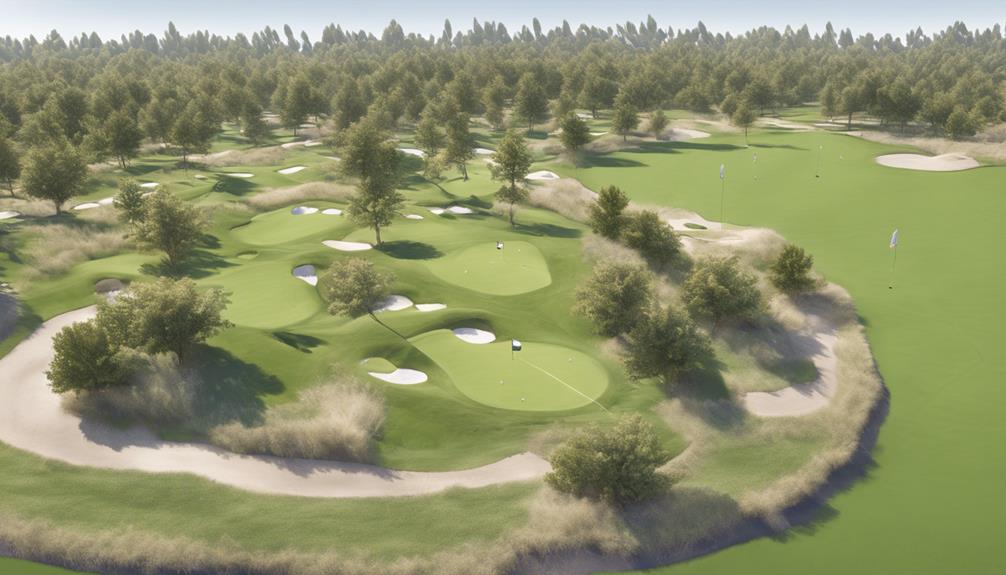Exploring Biodiversity in Golf Course Landscapes
Embark on a journey through the intricate web of biodiversity thriving in golf course landscapes. Diverse flora and fauna bolster ecosystem resilience, ensuring genetic robustness and pest control. Ecosystem balance is fostered by promoting pollinators and native plant species benefit wildlife populations. Bird-friendly habitats attract avian diversity, elevating overall biodiversity. Sustainable pest management practices and water conservation techniques enhance ecological health. Wildlife conservation efforts, coupled with biodiversity monitoring and community engagement, shape sustainable land management practices. Witness the wonders of biodiversity in golf courses and discover the secrets to promoting environmental richness and harmony.
Importance of Biodiversity in Golf Courses
The presence of diverse plant and animal species on golf courses plays a crucial role in enhancing ecosystem resilience and promoting sustainable land management practices. Promoting pollinators such as bees, butterflies, and birds within golf course landscapes is essential for maintaining ecological balance. These pollinators are instrumental in the reproduction of many plant species, ensuring genetic diversity and the health of ecosystems. By supporting pollinators, golf courses contribute to the overall biodiversity of an area, creating a thriving environment for various species to coexist.
Maintaining ecological balance on golf courses through the promotion of diverse plant and animal species leads to increased resilience against environmental stressors. Different species interact in complex ways, forming a web of relationships that stabilizes the ecosystem. For example, certain plants attract specific pollinators, which in turn help in the reproduction of these plants. This interconnectedness fosters a balanced environment where each species fulfills a unique role in supporting the overall health of the ecosystem.
Furthermore, biodiversity on golf courses can enhance pest control naturally through the presence of predator species that keep pest populations in check. This reduces the need for harmful pesticides, promoting a more sustainable approach to land management. By encouraging a diverse range of species to thrive, golf courses can create landscapes that aren't only aesthetically pleasing but also ecologically rich and resilient.
Native Plant Species for Wildlife
Enhancing wildlife habitat on golf courses can be achieved through strategic incorporation of native plant species. Native plants play a crucial role in supporting local ecosystems and promoting biodiversity. By utilizing native plant species, golf courses can create sustainable habitats that benefit various wildlife populations.
Here are some key ways in which native plant species can be beneficial for wildlife:
- Pollinator Gardens: Native plants are essential for creating pollinator-friendly habitats on golf courses. These plants attract bees, butterflies, and other pollinators crucial for ecosystem health and biodiversity.
- Habitat Restoration: Native plant species aid in habitat restoration efforts on golf courses. These plants provide food, shelter, and breeding sites for a variety of wildlife species, helping to restore natural balance and diversity.
- Biodiversity Support: Native plants enhance biodiversity by attracting a wide range of wildlife species, from birds to insects. This diverse ecosystem contributes to the overall health and resilience of the golf course environment.
- Ecosystem Services: Native plant species offer valuable ecosystem services, such as soil stabilization, water filtration, and carbon sequestration. By incorporating these plants, golf courses can improve environmental sustainability while providing habitat for wildlife.
Enhancing Habitats for Birds
Incorporating diverse bird-friendly habitats on golf courses is crucial for promoting avian biodiversity and ecosystem health. Bird nesting sites play a vital role in supporting bird populations, contributing to the overall balance of the ecosystem. Habitat restoration efforts aimed at enhancing bird habitats on golf courses can have significant positive impacts on avian diversity.
Research has shown that providing suitable vegetation for nesting can attract a variety of bird species to golf course landscapes. By incorporating native plants and creating undisturbed areas, golf courses can offer ideal conditions for birds to build nests and raise their young. This not only benefits the bird populations but also contributes to the overall ecological health of the area.
Habitat restoration projects on golf courses can include creating diverse vegetation structures, such as grasslands, shrublands, and forests, to cater to the varying needs of different bird species. By offering a range of habitats, golf courses can attract a more extensive array of birds, increasing the overall biodiversity of the area.
Sustainable Pest Management Practices
To promote biodiversity and ecological balance on golf courses, implementing sustainable pest management practices is essential. By adopting integrated pest management strategies, golf courses can effectively control pests while minimizing their impact on the environment.
Utilizing natural predators to keep pest populations in check is a key component of sustainable pest management practices. Here are some important points to consider:
- Utilize Beneficial Insects: Introducing beneficial insects like ladybugs or lacewings can help control harmful pest populations naturally.
- Implement Habitat Diversification: Creating diverse habitats within the golf course can attract natural predators, such as birds and bats, that feed on pests.
- Encourage Soil Health: Healthy soils promote strong plant growth, making them more resilient to pest infestations without the need for chemical interventions.
- Monitor Pest Populations: Regularly monitoring pest populations allows golf course managers to assess the effectiveness of pest management strategies and make adjustments as needed.
Water Conservation for Ecosystems
Exploring the impact of water conservation practices on ecosystems within golf course landscapes provides valuable insights into sustainable resource management strategies. Water conservation plays a crucial role in enhancing the resilience of ecosystems to drought conditions and supporting ecosystem restoration efforts.
Implementing water conservation measures such as using drought-resistant grass species, optimizing irrigation systems, and capturing and reusing rainwater can significantly enhance the drought resilience of golf course ecosystems. Studies have shown that sustainable water management practices not only reduce water consumption but also contribute to the overall health and biodiversity of these landscapes. By preserving water resources, golf courses can better withstand periods of water scarcity without compromising the integrity of the ecosystems they support.
Furthermore, efficient water conservation practices promote ecosystem restoration by maintaining the natural balance of water-dependent flora and fauna. Adequate water availability is essential for supporting wildlife habitats, promoting plant growth, and sustaining the overall biodiversity of golf course landscapes. By prioritizing water conservation, golf courses can create healthier ecosystems that are better equipped to recover from environmental disturbances and thrive in the long term. Ultimately, integrating water conservation strategies into golf course management is key to fostering sustainable ecosystems that benefit both the environment and the community.
Impact of Chemicals on Wildlife
Analyzing the impact of chemicals on wildlife populations reveals crucial insights into the potential threats posed by environmental contaminants in golf course ecosystems. Wildlife conservation is a key concern when considering chemical exposure in these environments. Here are some key points to consider:
- Chemical Exposure: Wildlife in golf course landscapes are at risk of exposure to a variety of chemicals, including fertilizers, herbicides, and pesticides. These substances can have detrimental effects on the health and well-being of animals living in these areas.
- Ecological Balance: The use of toxic pesticides on golf courses can disrupt the delicate ecological balance of these habitats. This imbalance can lead to a decline in biodiversity as certain species are negatively impacted by the presence of these chemicals.
- Wildlife Conservation: Protecting the wildlife that inhabits golf course landscapes is essential for maintaining healthy ecosystems. Strategies to minimize chemical exposure and promote coexistence between wildlife and golf course activities are crucial for long-term conservation efforts.
- Research Findings: Studies have shown a direct correlation between the use of certain chemicals on golf courses and declines in wildlife populations. Understanding these research findings is vital for implementing effective conservation measures to mitigate the impact of chemicals on wildlife.
Biodiversity Monitoring Techniques

The examination of biodiversity monitoring techniques provides valuable insights into assessing the ecological health of golf course landscapes. Remote sensing plays a crucial role in monitoring biodiversity on golf courses. This technology allows for the collection of data from a distance, enabling the assessment of vegetation cover, habitat diversity, and wildlife populations. By utilizing remote sensing techniques such as satellite imagery and drones, golf course managers can obtain comprehensive information about the biodiversity present on their grounds. This data can help identify areas of high biodiversity that may require conservation efforts or habitat restoration.
In addition to remote sensing, citizen science has emerged as a valuable tool for monitoring biodiversity on golf courses. Engaging golfers, local communities, and environmental enthusiasts in data collection can significantly enhance the monitoring process. Citizen science projects involving birdwatching, plant surveys, and wildlife tracking can provide valuable information about the biodiversity present on golf courses. By involving the community in biodiversity monitoring, golf courses can foster a sense of stewardship and environmental awareness among their stakeholders.
Community Engagement in Conservation
Community engagement in conservation efforts within golf course landscapes is crucial for success. Golf courses can serve as community hubs for environmental education and outreach, fostering partnerships with local residents, schools, and environmental organizations. By involving the community in conservation projects, awareness about biodiversity preservation is raised significantly. Through education programs and outreach, golf courses can promote sustainable land management practices, benefiting wildlife and the community. Active participation in conservation activities fosters a sense of ownership and pride in the local environment, leading to long-term stewardship.
Education programs tailored to different age groups and demographics effectively communicate the importance of preserving biodiversity on golf courses. Integrating community outreach into conservation strategies transforms golf courses into not just recreational spaces but also valuable contributors to environmental protection.
Frequently Asked Questions
How Can Golf Courses Support Pollinator Populations?
To support pollinator populations on golf courses, consider incorporating native plantings and habitat restoration efforts.
Implementing integrated pest management practices can reduce pesticide use, benefiting pollinators.
Wildflower plantings can provide essential food sources for bees and butterflies.
What Is the Role of Fungi in Golf Course Biodiversity?
Fungi diversity plays a crucial role in ecosystem health, including on golf courses. They contribute to nutrient cycling, plant growth, and overall biodiversity.
By forming symbiotic relationships with plants, fungi improve soil structure and help plants access essential nutrients. Additionally, some fungi can break down pollutants, enhancing environmental quality.
Understanding and supporting fungi diversity on golf courses can lead to healthier ecosystems and more sustainable landscapes.
Are There Any Specific Reptile-Friendly Practices on Golf Courses?
To promote reptile-friendly practices on golf courses, consider habitat restoration and conservation initiatives. Implement reptile population monitoring and habitat management strategies to support biodiversity.
How Do Golf Courses Contribute to Amphibian Conservation?
To help amphibian conservation, golf courses contribute by engaging in wetland restoration and habitat creation. These efforts improve water quality and support conservation initiatives aimed at protecting amphibian populations.
Can Golf Courses Help Protect Endangered Plant Species?
To protect endangered plant species, golf courses can play a crucial role through habitat restoration initiatives and conservation partnerships. By creating suitable habitats and collaborating with conservation organizations, golf courses enhance genetic diversity and promote ecosystem resilience.
These efforts not only benefit the endangered plant species directly but also contribute to overall biodiversity conservation. Utilizing available resources and expertise, golf courses can make a significant impact in safeguarding vulnerable plant populations.
Conclusion
In conclusion, exploring biodiversity in golf course landscapes is essential for creating sustainable ecosystems that benefit wildlife and enhance natural habitats.
By incorporating native plant species, implementing sustainable pest management practices, and monitoring biodiversity levels, golf courses can play a significant role in conservation efforts.
Through community engagement and a commitment to environmental stewardship, golf courses have the opportunity to contribute positively to biodiversity conservation and create a healthier environment for all species.
